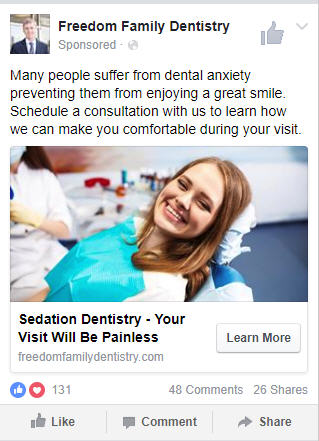If you’re an orthodontist looking to reach more potential patients and grow your practice, Facebook Ads could be the game-changer you’ve been searching for. With over 2.7 billion monthly active users worldwide, Facebook provides an unparalleled platform for targeting and engaging with your ideal audience. In this article, we’ll explore the power of Facebook Ads for orthodontists and uncover strategies to help you maximize your ad campaigns’ efficiency and effectiveness. Whether you’re a seasoned advertiser or new to the world of digital marketing, this guide will equip you with the tools and knowledge to achieve success with Facebook Ads.
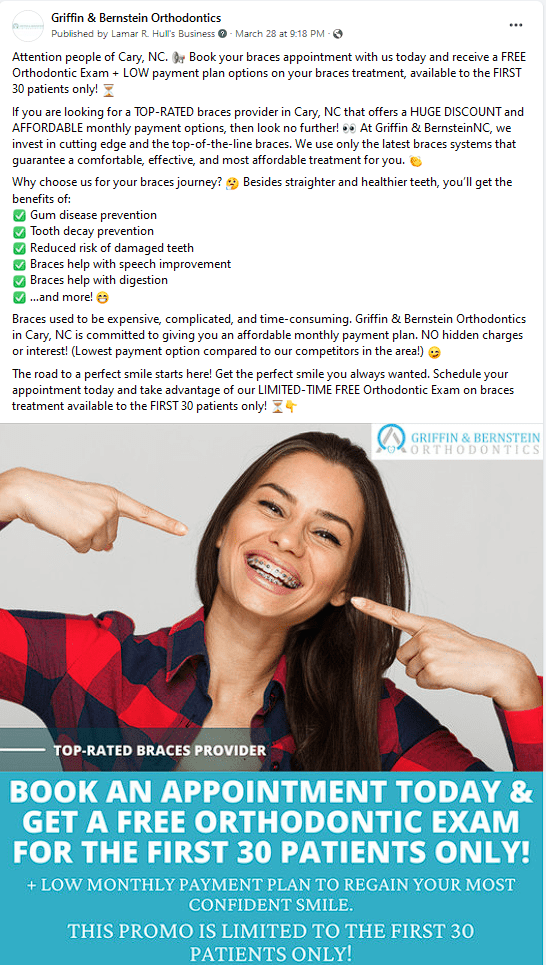
1. Understanding the Importance of Facebook Ads for Orthodontists
In today’s digital age, social media platforms have become powerful marketing tools for businesses across various industries, including the field of orthodontics. Facebook, in particular, offers numerous benefits for orthodontists looking to expand their reach and promote their services effectively.
1.1 Reach a Larger Audience
One of the primary advantages of utilizing Facebook ads for orthodontists is the ability to reach a larger audience. With over 2.8 billion monthly active users, Facebook provides an expansive user base to tap into. By utilizing targeted advertising strategies, orthodontists can ensure that their ads are seen by potential patients who may be interested in their services. This wide reach allows orthodontists to increase brand exposure and attract a larger pool of potential clients.
1.2 Targeting Specific Demographics
Facebook ads provide orthodontists with the opportunity to target specific demographics within their desired market. Through precise audience targeting, orthodontists can narrow down their advertising efforts to reach individuals of a particular age group, location, and other relevant characteristics. This level of specificity ensures that orthodontists are delivering their ads to the right people, resulting in higher engagement and conversion rates.
1.3 Cost-Effective Advertising
Compared to traditional advertising methods such as print ads or billboards, Facebook ads offer a cost-effective solution for orthodontists. With Facebook’s advanced targeting capabilities, orthodontists can allocate their budgets efficiently, ensuring that their ads are displayed to individuals who are more likely to convert into patients. The ability to set daily or lifetime budgets allows orthodontists to have better control over their advertising expenses and maximize their return on investment.
1.4 Building Brand Awareness
Establishing a strong brand presence is crucial for orthodontists seeking to differentiate themselves from competitors. Facebook ads provide an effective platform for building brand awareness within the target market. By consistently delivering visually appealing and engaging content, orthodontists can capture the attention of potential patients. Moreover, the interactive nature of Facebook ads allows orthodontists to engage directly with their audience through comments, messages, and shares, further enhancing brand recognition and fostering trust.
1.5 Increasing Website Traffic
In addition to raising brand awareness, Facebook ads can drive traffic to orthodontists’ websites, providing a direct path for potential patients to learn more about their services. By strategically placing calls-to-action in their ads, such as “Learn More” or “Schedule a Consultation,” orthodontists can guide interested individuals to their websites, where they can find detailed information, access online resources, and ultimately take the next steps towards becoming new patients.
2. Setting Up a Facebook Ad Account
To leverage the benefits of Facebook ads, orthodontists first need to set up their Facebook ad account. This involves creating a Business Manager account, adding and managing pages, configuring ad account settings, and linking payment methods.
2.1 Creating a Business Manager Account
Creating a Business Manager account is the first step in setting up a Facebook ad account for orthodontists. Business Manager is a centralized hub that allows orthodontists to manage their ad accounts, pages, and advertising assets. By creating a Business Manager account, orthodontists can organize their Facebook ad activities more efficiently, ensuring a seamless experience throughout the ad creation and campaign management process.
2.2 Adding and Managing Pages
Within the Business Manager account, orthodontists need to add and manage their Facebook business pages. These pages serve as the primary platform for running and promoting ads. Orthodontists should create a dedicated business page for their practice, providing essential information such as contact details, services offered, and a brief overview of the practice. Managing the pages within Business Manager allows orthodontists to maintain consistent branding and easily switch between different pages if they have multiple locations or practices.
2.3 Configuring Ad Account Settings
Configuring ad account settings is a crucial step in the setup process. Orthodontists should ensure that their ad account settings align with their advertising goals and preferences. This includes setting default currency, time zone, and any specific restrictions or limitations they may have. By carefully configuring these settings, orthodontists can have better control over their advertising campaigns and accurately analyze their performance.
2.4 Ad Account Roles and Permissions
Given the collaborative nature of Facebook ad account management, orthodontists should assign roles and permissions to individuals involved in the ad creation and management process. Business Manager allows orthodontists to grant specific access levels to team members, ensuring that only authorized individuals can perform certain actions within the ad account. This control over roles and permissions enhances security and accountability within the advertising workflow.
2.5 Linking Payment Methods
To start running Facebook ads, orthodontists must link a valid payment method to their ad account. Facebook offers various payment options, including credit or debit cards and PayPal. By linking a payment method, orthodontists can easily pay for their Facebook ad campaigns and keep track of their advertising expenses.
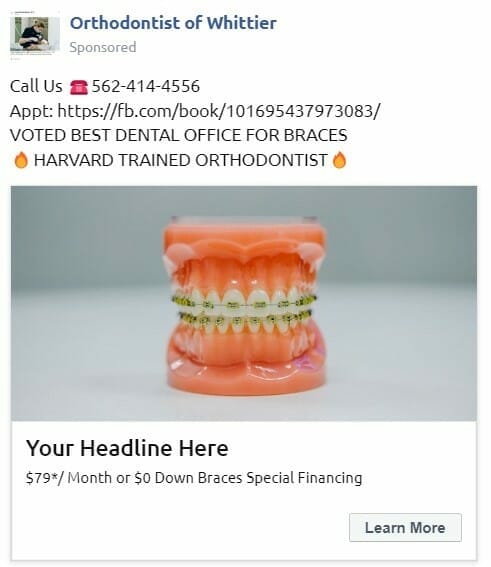
3. Defining Your Facebook Ads Strategy
Before diving into creating Facebook ads, orthodontists must define a comprehensive advertising strategy. This involves identifying the target audience, setting advertising goals, creating compelling ad creatives, determining ad placement, and budgeting and scheduling ads effectively.
3.1 Identifying Your Target Audience
To maximize the effectiveness of Facebook ads, orthodontists should clearly define their target audience. By understanding the demographic and psychographic characteristics of their ideal patients, orthodontists can tailor their ad content and targeting criteria to reach the right individuals. Factors such as age, location, interests, and behaviors can help narrow down the target audience and ensure that ads are displayed to those most likely to be interested in orthodontic services.
3.2 Setting Clear Advertising Goals
Setting clear advertising goals is essential for measuring the success of Facebook ad campaigns. Orthodontists should establish specific objectives based on their practice’s needs and priorities. These goals may include increasing website traffic, boosting appointment bookings, generating leads, or promoting specific treatments or offers. By outlining these goals, orthodontists can align their ad strategies and monitor their progress throughout the campaign.
3.3 Creating Compelling Ad Creatives
The visual appeal and content of Facebook ads play a significant role in capturing the attention and interest of potential patients. Orthodontists should invest time and effort in creating compelling ad creatives that stand out in users’ news feeds. High-quality images or videos showcasing before-and-after treatment results, happy patients, or the orthodontist and the practice can help generate interest and engagement. Furthermore, incorporating persuasive ad copy that highlights the benefits of orthodontic treatment can encourage users to take action.
3.4 Determining Ad Placement
Facebook offers various ad placement options, including the news feed, right column, instant articles, in-stream videos, and more. Orthodontists should carefully consider their target audience’s behavior and preferences to determine the most effective ad placements. For instance, news feed ads can reach a broader audience, while right column ads may appeal to users specifically browsing through the desktop version. By strategically selecting ad placements, orthodontists can optimize ad visibility and engagement.
3.5 Budgeting and Scheduling Ads
Orthodontists need to set realistic budgets for their Facebook ad campaigns and decide on a suitable ad scheduling strategy. Facebook advertising allows orthodontists to choose between daily budgets (an allocated amount spent per day) or lifetime budgets (an allocated amount spent throughout the entire campaign duration). Deciding on the appropriate budget allocation and scheduling ensures that orthodontists make the most of their available budget and reach their target audience at the optimal times.
4. Choosing the Right Ad Formats
Facebook offers a variety of ad formats to cater to different campaign goals and creative preferences. Orthodontists should choose the ad formats that best align with their advertising objectives and effectively showcase their services.
4.1 Photo Ads
Photo ads are one of the most straightforward and widely-used ad formats on Facebook. Orthodontists can use compelling images to capture users’ attention and promote their services. For instance, a photo ad can feature a smiling patient with straight teeth to highlight the transformation achieved through orthodontic treatment.
4.2 Video Ads
Video ads provide orthodontists with an engaging way to communicate their message. Through videos, orthodontists can showcase their practice, introduce the orthodontist and the team, and explain different treatment options in a visually appealing manner. Video ads are highly effective in capturing users’ attention and conveying key information effectively.
4.3 Carousel Ads
Carousel ads allow orthodontists to display multiple images or videos within a single ad unit. Orthodontists can utilize this format to showcase various treatment options, highlight different patient stories, or present before-and-after results. The interactive nature of carousel ads encourages users to engage with the content, increasing the likelihood of conversions.
4.4 Slideshow Ads
Slideshow ads offer a dynamic and cost-effective alternative to video ads. Orthodontists can create slideshows comprised of multiple images with animations or transitions. Slideshow ads enable orthodontists to tell a story or present a visual journey of orthodontic treatment, effectively conveying their message without the need for costly video production.
4.5 Collection Ads
Collection ads are designed to promote products or services by combining a video or image with relevant product listings. Orthodontists can leverage this format to showcase specific treatments, such as different types of braces or aligners. By providing users with a visually appealing and interactive experience, collection ads can drive engagement and conversion.
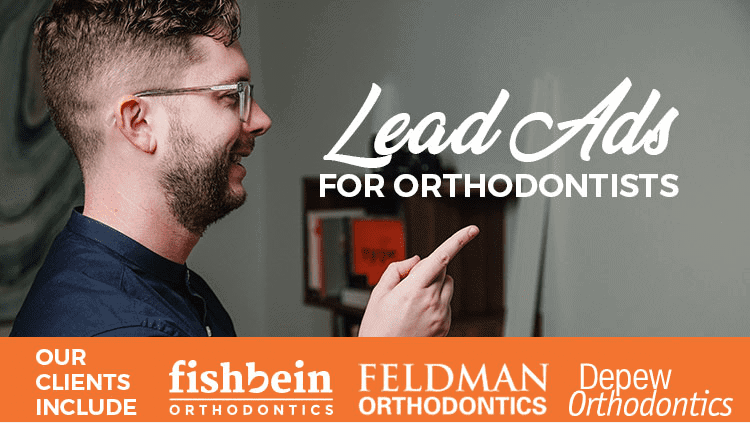
5. Creating Engaging Ad Content
In addition to selecting the right ad format, orthodontists must create engaging ad content to capture users’ attention and encourage them to take action.
5.1 Crafting Attention-Grabbing Headlines
The headline of a Facebook ad plays a crucial role in attracting users’ attention. Orthodontists should craft compelling headlines that clearly communicate the value proposition and entice users to learn more. For example, “Achieve a Perfect Smile with Our Advanced Orthodontic Treatments” captures attention and addresses the desired outcome of potential patients.
5.2 Writing Persuasive Ad Copy
The ad copy should provide concise yet persuasive information about the orthodontic services. Orthodontists should highlight the benefits patients can expect from treatment, address any concerns they might have, and offer unique selling points that differentiate their practice. By focusing on the specific pain points and desires of potential patients, orthodontists can construct a persuasive message that resonates with their target audience.
5.3 Including Eye-Catching Visuals
Visuals are essential for capturing users’ attention and making ads visually appealing. Orthodontists should select high-quality images or videos that effectively showcase the transformation achievable through orthodontic treatment. Including before-and-after photos, images of smiling patients, or visual depictions of treatment options can create an emotional connection and generate interest among users.
5.4 Adding Clear Call-to-Actions
Every Facebook ad should include a clear call-to-action (CTA) that guides users towards the desired action. Orthodontists can use CTAs such as “Book Now,” “Schedule a Consultation,” or “Learn More” to encourage potential patients to take the next step. By providing a clear and compelling CTA, orthodontists can drive users to their website or landing page, increasing the chances of converting them into patients.
5.5 A/B Testing Different Approaches
To optimize ad performance, orthodontists should conduct A/B testing to compare the effectiveness of different ad elements or approaches. By testing variables such as headlines, images, ad copy, or CTAs, orthodontists can gather valuable insights into what resonates best with their target audience. A/B testing allows orthodontists to make data-driven decisions and continuously refine their ad content for maximum engagement and conversion.
6. Implementing Effective Targeting Strategies
To ensure that Facebook ads reach the most relevant audience, orthodontists need to implement effective targeting strategies. Facebook offers various targeting options that allow orthodontists to deliver their ads to individuals who are most likely to be interested in their services.
6.1 Geographic Targeting
Geographic targeting allows orthodontists to specify the locations where they want their ads to be displayed. Orthodontists can target specific cities, regions, or even particular ZIP codes. This level of targeting ensures that ads are shown to individuals within the orthodontist’s service area, preventing wasteful ad impressions on users who are unlikely to travel for treatment.
6.2 Age and Gender Targeting
Orthodontists can target specific age groups and genders to tailor their ads to their desired demographic. For example, orthodontists may want to target young adults or parents who are looking for orthodontic treatment options for their children. By refining the targeting based on age and gender, orthodontists can increase the relevance and effectiveness of their ads.
6.3 Interest-Based Targeting
Interest-based targeting allows orthodontists to reach individuals who have expressed interest in topics related to orthodontics. Orthodontists can select relevant interests, such as dental health, braces, or orthodontic treatment, to ensure that their ads are shown to users who have demonstrated an interest in similar topics. This targeting method helps orthodontists connect with users who are actively seeking information or solutions related to orthodontic care.
6.4 Custom Audiences
Utilizing custom audiences allows orthodontists to target individuals who have already interacted with their practice in some way. Custom audiences can be created based on various criteria, such as website visitors, email subscribers, or individuals who have engaged with the practice’s Facebook page or Instagram profile. Targeting custom audiences ensures that ads are shown to individuals who already have some level of familiarity with the orthodontist’s brand, increasing the likelihood of conversions.
6.5 Lookalike Audiences
Lookalike audiences enable orthodontists to expand their reach by targeting individuals who have similar characteristics and behaviors to their existing custom audiences. By utilizing the data from custom audiences, Facebook identifies users who share similar demographics and interests. Targeting lookalike audiences allows orthodontists to tap into new potential patient pools that align with their existing patient base.
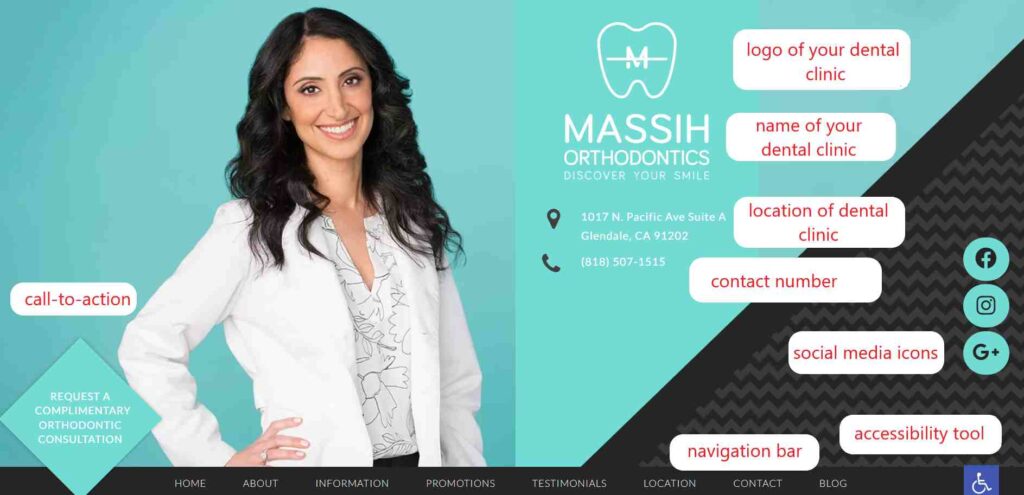
7. Maximizing Ad Performance through Optimization
To achieve optimal results from Facebook ads, orthodontists must continuously monitor and optimize their campaigns. This involves analyzing ad metrics, conducting split tests, retargeting website visitors, optimizing landing pages, and continuously refining ad campaigns.
7.1 Monitoring and Analyzing Ad Metrics
Orthodontists should consistently monitor and analyze key ad metrics to gain insights into their campaign performance. Metrics such as impressions, reach, click-through rates (CTR), conversion rates, and cost per conversion provide valuable data for assessing ad effectiveness. By identifying trends, patterns, and areas for improvement, orthodontists can make data-driven decisions and adjust their strategies accordingly.
7.2 Conducting Split Tests
Split testing, or A/B testing, involves comparing different ad variations to determine which performs better. Orthodontists can test different headlines, images, ad copies, CTAs, or targeting options to identify the most effective combinations. Split tests provide valuable insights into what resonates with the target audience and enable orthodontists to optimize their ads for better performance.
7.3 Retargeting Website Visitors
Retargeting website visitors is an effective strategy to re-engage users who have shown initial interest in the orthodontist’s services. By utilizing Facebook’s pixel tracking code, orthodontists can create custom audiences consisting of users who have visited their website. Orthodontists can then deliver tailored ads to these audiences, reminding them of their services and encouraging them to take the next step, such as scheduling a consultation.
7.4 Optimizing Landing Pages
Landing pages play a critical role in converting ad clicks into actual appointments or inquiries. Orthodontists should ensure that their landing pages are optimized for a seamless user experience and clearly communicate the value proposition. The landing pages should have a clear call-to-action, relevant information about the practice and services, and contact forms for users to submit their details. By continuously optimizing landing pages, orthodontists can improve conversion rates and maximize the ROI of their Facebook ad campaigns.
7.5 Continuously Refining Ad Campaigns
As with any marketing activity, continuous refinement is essential for achieving long-term success with Facebook ads. Orthodontists should regularly review campaign performance, identify areas for improvement, and adjust their targeting, ad creatives, and budgets accordingly. By adopting a proactive approach to campaign refinement, orthodontists can ensure that their ads stay relevant, engaging, and effective in reaching their advertising goals.
8. Utilizing Advanced Facebook Ad Features
Orthodontists can take advantage of advanced Facebook ad features to further enhance their campaigns and improve results.
8.1 Facebook Pixel and Conversion Tracking
Facebook Pixel is a powerful tool that allows orthodontists to track users’ actions on their website and measure ad effectiveness. By installing the Facebook Pixel on their website, orthodontists can gain valuable insights into user behavior, optimize campaigns for conversions, and retarget website visitors more effectively. Conversion tracking enables orthodontists to attribute specific actions, such as appointment bookings or form submissions, to their Facebook ads, providing a clear understanding of the campaign’s impact.
8.2 Dynamic Ads and Product Catalogs
Dynamic ads enable orthodontists to automatically promote relevant products or services to individuals who have shown interest on their website or app. By utilizing a product catalog and leveraging Facebook’s algorithms, orthodontists can dynamically display ads tailored to users’ preferences and prior interactions. This personalized approach increases the chances of conversions and improves the overall user experience.
8.3 Lead Generation Ads
Lead generation ads allow orthodontists to collect valuable information from potential patients directly through Facebook. By utilizing custom forms within the ad unit, orthodontists can capture leads’ contact details, preferences, or specific questions before they even leave the Facebook platform. Lead generation ads simplify the process of gathering user information, streamlining lead generation efforts and seamlessly integrating with orthodontists’ customer relationship management (CRM) systems.
8.4 Messenger Ads
Messenger ads provide orthodontists with an opportunity to engage directly with users through Facebook’s Messenger platform. Orthodontists can utilize Messenger ads to foster two-way communication, answer questions, provide additional information, or even schedule appointments. By leveraging the power of conversation, orthodontists can build relationships and establish trust with potential patients in a more personalized and interactive manner.
8.5 Video Ads with Interactive Features
Interactive video ads combine the engaging nature of videos with interactive elements to capture users’ attention and encourage them to engage further. Orthodontists can incorporate features such as polls, quizzes, or interactive hotspots within their video ads to enhance user participation and provide a more immersive experience. Interactive video ads foster user engagement, increase brand recall, and drive conversions.
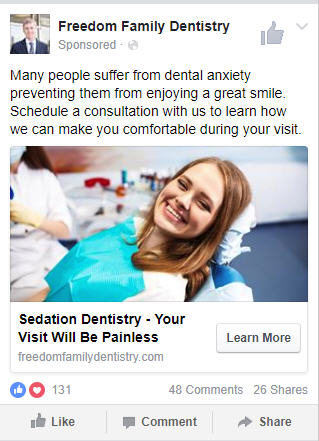
9. Compliance with Facebook Ad Policies
Orthodontists must ensure that their Facebook ads comply with Facebook’s advertising guidelines and policies to avoid disapprovals or other penalties.
9.1 Understanding Advertising Guidelines
Orthodontists should familiarize themselves with Facebook’s advertising guidelines to ensure that their ads meet the platform’s standards. These guidelines cover various aspects, such as prohibited content, image restrictions, including acceptable and unacceptable practices. By adhering to these guidelines, orthodontists can maintain a positive reputation and prevent their ads from being rejected.
9.2 Ad Content and Design Restrictions
Facebook imposes certain restrictions on ad content and designs to maintain a user-friendly environment. Orthodontists should ensure that their ads do not contain misleading information, offensive or discriminatory content, or excessive use of text overlays on images. Ad designs should also comply with Facebook’s formatting guidelines and aspect ratio requirements to ensure optimal display on different devices and placements.
9.3 Monitoring and Resolving Ad Disapprovals
Orthodontists should regularly monitor their ad account for any disapproved ads and take prompt action. If an ad is disapproved, orthodontists should carefully review Facebook’s feedback or guidelines for rectification. Adjustments can be made to the ad content, targeting criteria, or creative components to address Facebook’s concerns. By promptly resolving ad disapprovals, orthodontists can ensure a smooth advertising experience and maintain their campaigns’ momentum.
9.4 Staying Up-to-Date with Policy Changes
Facebook’s ad policies and guidelines are subject to change over time. Orthodontists should stay informed about any updates or modifications to the platform’s policies. Regularly checking for policy updates and reviewing the latest guidelines ensures that orthodontists’ ads remain compliant and prevent any potential disruptions to their campaigns.
9.5 Complying with Privacy Regulations
Orthodontists must also comply with relevant privacy regulations, such as the General Data Protection Regulation (GDPR) or the California Consumer Privacy Act (CCPA). These regulations dictate how orthodontists handle user data, including data collected through Facebook ads. Orthodontists should ensure that they have appropriate mechanisms in place to obtain user consent, securely handle personal information, and comply with privacy laws.
10. Tracking and Measuring Ad Performance
To assess the effectiveness of their Facebook ad campaigns, orthodontists need to implement tracking mechanisms and measure key performance metrics.
10.1 Setting Up Facebook Pixel
Setting up Facebook Pixel allows orthodontists to track user interactions on their website and attributes conversions to their Facebook ads. Orthodontists should ensure that their website is properly integrated with the Facebook Pixel tracking code to capture valuable data. By setting up Facebook Pixel correctly, orthodontists can gain insights into user behavior and measure the impact of their campaigns accurately.
10.2 Monitoring Impressions and Reach
Impressions and reach metrics provide orthodontists with an understanding of how many users have seen their ads and how frequently the ads are being displayed. By monitoring these metrics, orthodontists can assess their ad reach and optimize targeting strategies or adjust ad budgets to maximize impressions and reach within their target audience.
10.3 Analyzing Click-Through Rates
Click-through rate (CTR) measures the percentage of users who click on an ad after seeing it. Orthodontists should analyze CTR to gauge the effectiveness of their ad creatives and messaging. A high CTR suggests that the ad is resonating well with the target audience, while a low CTR may indicate the need for adjustments to ad content or targeting.
10.4 Measuring Conversion Rates
Conversion rates are a vital metric for evaluating the success of Facebook ad campaigns. Orthodontists should measure the percentage of users who complete a desired action, such as booking an appointment or submitting a contact form, after clicking on an ad. By tracking conversion rates, orthodontists can assess the ROI of their campaigns and make informed decisions regarding budget allocations and optimization strategies.
10.5 Utilizing Analytics Tools for In-Depth Insights
Orthodontists can utilize additional analytics tools, such as Facebook Ads Manager or third-party analytics platforms, to gain in-depth insights into their Facebook ad performance. These tools provide detailed data on various metrics, audience demographics, campaign performance over time, and other valuable analytics. By leveraging these analytics tools, orthodontists can gain a deeper understanding of their target audience, optimize ad strategies, and drive continuous improvement in their Facebook ad campaigns.
In conclusion, Facebook ads offer orthodontists a powerful platform for reaching a larger audience, targeting specific demographics, and expanding brand awareness. By following the steps outlined in this comprehensive article, orthodontists can set up and optimize their Facebook ad accounts, create engaging ad content, implement effective targeting strategies, track and measure ad performance, and comply with Facebook’s ad policies. With careful planning, strategic execution, and continuous optimization, orthodontists can achieve success and drive significant growth and visibility for their practices through Facebook advertising.

